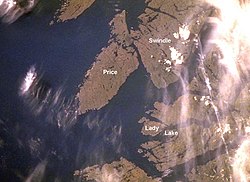History
The Heiltsuk peoples traditionally occupied the land around Milbanke Sound. [6] [7] [8]
In late June, 1788, the British fur trader Charles Duncan, captain of Princess Royal, entered Milbanke Sound, which was then uncharted waters. He spent a few days trading with the Heiltsuk. [9] He named the sound after Vice Admiral Mark Milbanke. [10] Explorer George Vancouver sailed through the sound a few years later. [8] [11] In 1805, a trading ship from Boston, the Atahualpa, was attacked by a group of Tlingit; the captain and some of the crew were killed. [12] [13]
In 1833 the Hudson's Bay Company established Fort McLoughlin in the Milbanke Sound area. [14] [15] William Fraser Tolmie was stationed there in 1833-1834. Tolmie wrote about the fur trade in the area, saying that it was conducted with the Coast Tsimshians and Heiltsuks, using a pidgin jargon composed of the Kaigani and Tshatshinni dialects of Haida and English. Chinook Jargon, commonly used elsewhere, was not widely known in Milbanke Sound at the time. [16] The fort operated for about ten years, and then was abandoned; the company later opened a small store at the same location. [17]
To improve the safety of the developing travel and shipping lanes, a lighthouse was built in 1898 at Robb Point on Ivory Island. [18]
In recent times archaeological investigations have been carried out in the Milbanke Sound area. [19] [20]
This page is based on this
Wikipedia article Text is available under the
CC BY-SA 4.0 license; additional terms may apply.
Images, videos and audio are available under their respective licenses.

